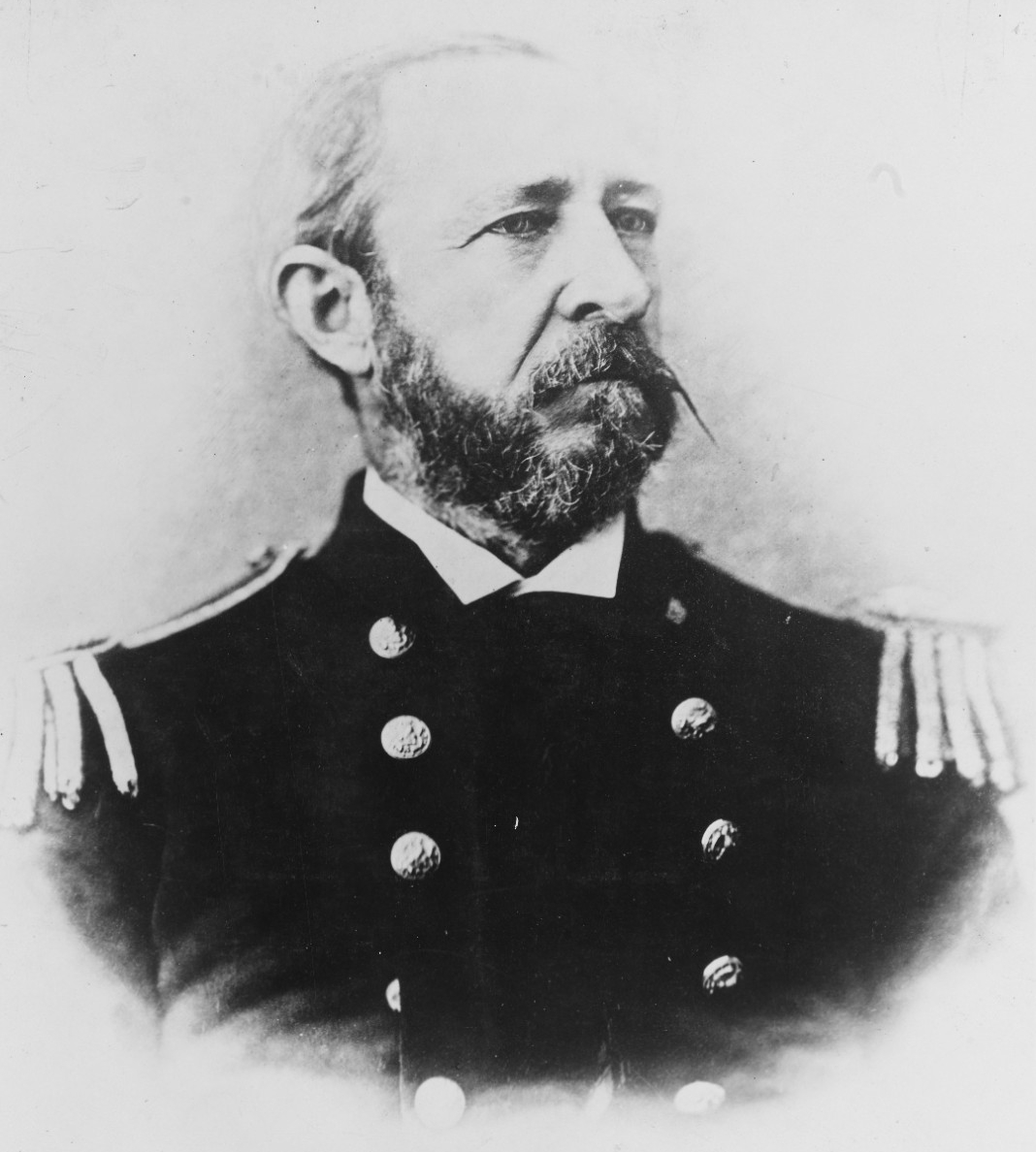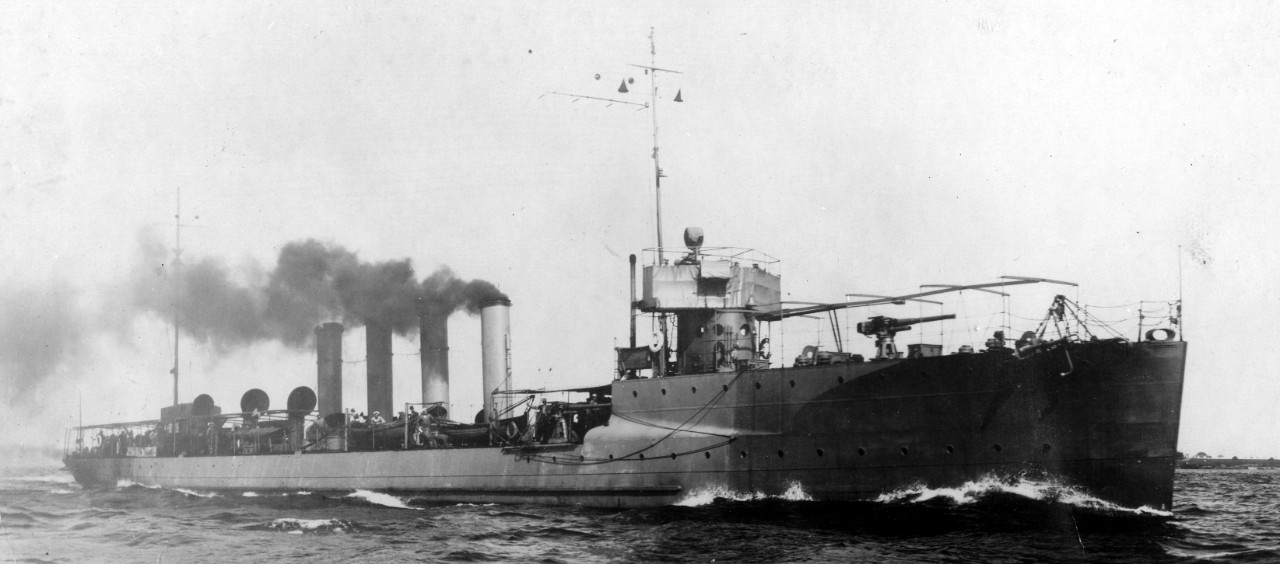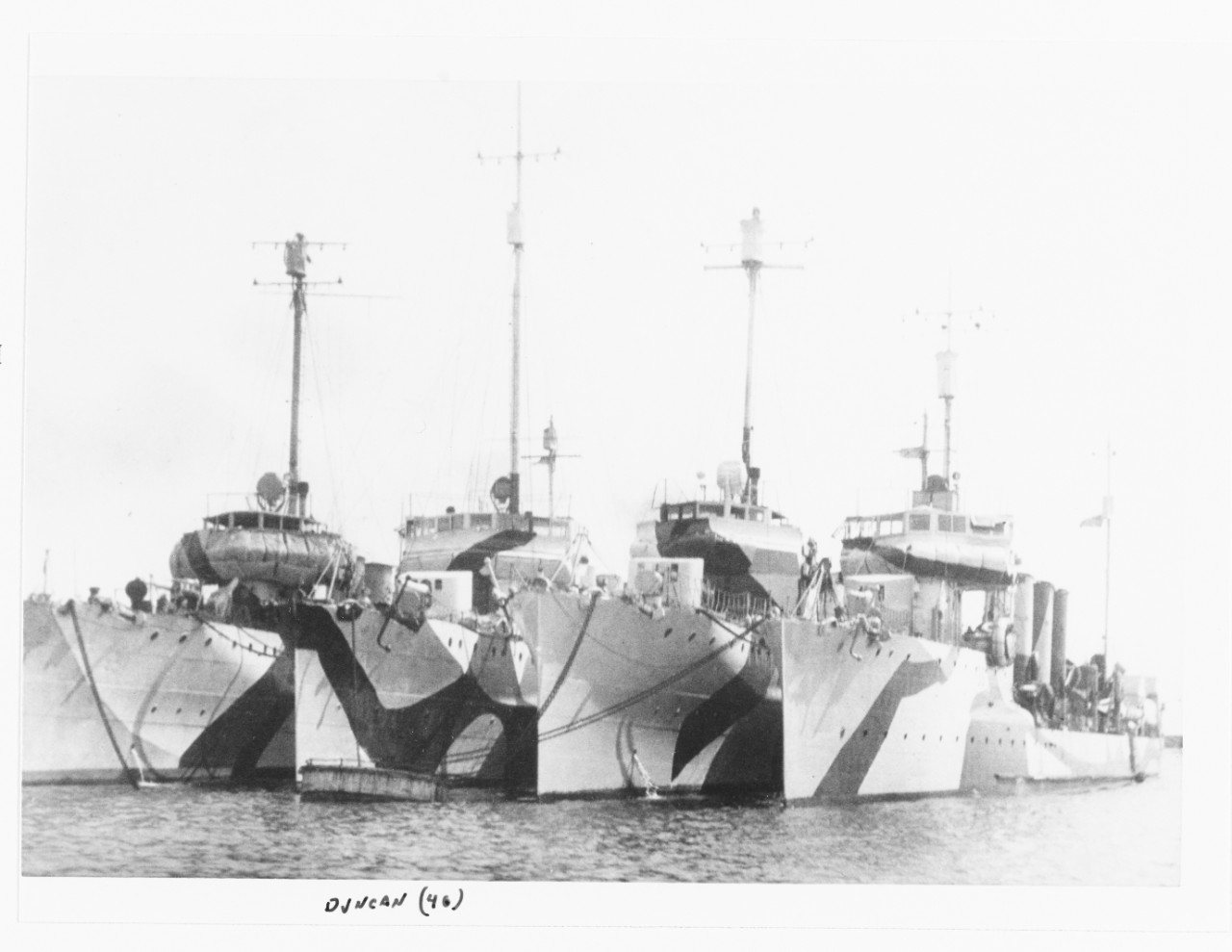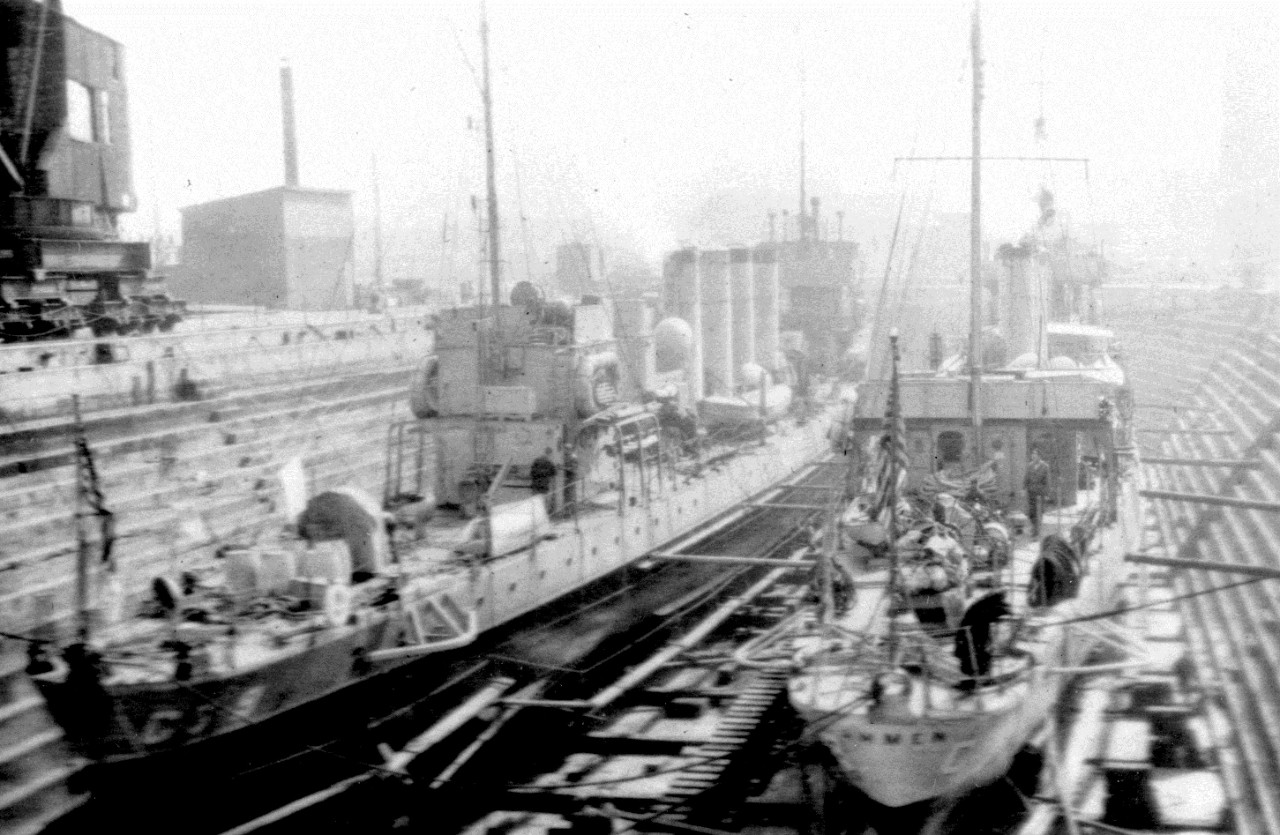Ammen I (Destroyer No. 35)
1911-1933
Daniel Ammen – born in Brown County, Ohio on 15 May 1820 – was appointed a midshipman in the U.S. Navy on 7 July 1836 and on 30 September was ordered to the store ship Relief attached to the South Seas Surveying and Exploring Expedition; on 1 July 1837 he transferred to the frigate Macedonian, preparing for service with that expedition. From March 1838 to November 1839, Ammen cruised in the West Indies in the sloops-of-war Levant and Vandalia. In March 1840, he was ordered to Preble, and following a cruise along the coast of Labrador, the sloop-of-war sailed for the Mediterranean on 12 January 1841 to join the squadron of Commodore Charles W. Morgan. In May, Ammen was transferred to the ship-of-the-line Ohio, in which he returned to Boston in July 1841.
After attending the Naval School at Philadelphia during the winter of 1841-42, Ammen was promoted to passed midshipman on 1 July 1842. That fall, he performed survey duty in Delaware Bay and in 1843 served in the receiving ship Experiment at Philadelphia and the frigate Savannah, preparing for sea at New York. Previous to Savannah’s sailing for the Pacific in October 1843, Ammen was transferred to the store ship Lexington, in which he made several trips to the Mediterranean to deliver supplies. From April 1845 to April 1847, he was attached to the sloop-of-war Vincennes on a cruise in the East Indies; then 1847-49, served on coast survey duty.
Ammen was promoted to the rank of master on 10 May 1849 and to that of lieutenant on 4 November 1849. In October of that year, he was granted three months’ leave with permission to visit Europe and then join the Mediterranean Squadron. He was assigned to duty on board the frigate St. Lawrence by Commodore Morgan in the Mediterranean, and returned to the U.S. in that vessel in November 1850.
Following another tour of coast survey duty, Lt. Ammen received orders to the steamer Water Witch which sailed for South America on 8 February 1853, under the command of Lt. Thomas J. Page, on an expedition to explore the La Plata and Parama Rivers. In May 1854, he was detached from Water Witch and assigned to duty on the brigantine Bainbridge in the Brazil Squadron. Upon the return of Bainbridge to the United States in January 1855, Lt. Ammen was detached and granted three months’ leave. In April, he reported for duty at the Naval Observatory, Washington, D.C. Ammen was detached in August 1857 and ordered to the steamer Saranac, which subsequently sailed for the Pacific. Ammen was transferred to the screw frigate Merrimack, flagship of the Pacific Squadron, in June 1858, and he remained in that vessel until her return to the U.S. in February 1860. On 20 March, he was ordered to the Naval Rendezvous at Baltimore, Md., where he was on duty at the outbreak of the Civil War.
In May 1861, Lt. Ammen was ordered to the screw frigate Roanoke, in which he served in the North Atlantic Squadron until September when he was ordered to command the gunboat Seneca, assigned to the South Atlantic Blockading Squadron. While under Ammen’s command, Seneca took part in the battle of Port Royal on 7 November, the expedition up Wassaw Sound on 5 December, the attack on the Port Royal Ferry on 1-2 January 1862, the expedition up the Wilmington River from 26-29 January, and shared in the capture of several Confederate vessels and the town of Fernandina, Fla.
Promoted to the grade of commander on 16 July 1862, Ammen was transferred from Seneca to the gunboat Sebago, which he commanded only a short time then returned north, reporting his arrival at Washington, D.C. on 4 October 1862. On 11 October, he was ordered to command the ironclad steamer Patapsco, then building at Wilmington, Del. This vessel was placed in commission on 2 January 1863 and on 2 February, Cmdr. Ammen reported with her at Beaufort, N.C., for duty with the South Atlantic Blockading Squadron. Patapsco took part in the attack on Fort McAllister on 3 March and in the operations against the forts in Charleston Harbor on 7 April.
Detached from Patapsco because of ill health in June 1863 and ordered north, Ammen remained on sick leave until September, when he returned to duty with the South Atlantic Blockading Squadron as an aide on the staff of Rear Adm. John A. Dahlgren, the steamer Philadelphia, flagship, and took part in the operations against Charleston, S.C., that fall. However, in January 1864, he was again found “unfit for service” by a medical survey and authorized to return north to recover his health.
During March and April 1864, Ammen served as temporary commander of the screw sloop-of-war Shenandoah, North Atlantic Blockading Squadron. From October 1864 to 17 January 1865, he commanded the screw sloop-of-war Mohican on blockade duty off Wilmington, N.C., participating in the attacks on Fort Fisher on 24-25 December 1864 and on 13-15 January 1865. From 17 January to 7 March 1865, he was attached to the South Atlantic Blockading Squadron, operating off Charleston. Upon arrival of Mohican at the Boston Navy Yard in April, Cmdr. Ammen was detached from command and the vessel placed out of commission.
In July and August 1865, Ammen was employed in the recovery of naval machinery at Charlotte and other points in North Carolina. From September 1865 to March 1866, he was in command of the monitor Miantonomoh in the North Atlantic Squadron. Promoted to captain on 25 July 1866, he served on special duty at Hartford, Conn. from November 1866 to August 1867; then commanded the steamer Piscataqua from August 1867 to February 1869. Piscataqua sailed for the Asiatic Station on 16 December 1867, where she served as the flagship of Adm. Stephen C. Rowan. Ammen was detached from this vessel in February 1869, and upon his return to the U.S. was appointed Chief of the Bureau of Yards and Docks, serving in this capacity from May 1869 to October 1871 and later as Chief of the Bureau of Navigation from 1871 to 1878. He was promoted to commodore on 1 April 1872, rear admiral on 11 December 1877, and placed on the Retired List on 4 June 1878.
Rear Adm. Ammen died on 11 July 1898 in Washington, D.C., and was interred at Arlington [Va.] National Cemetery.

I
(Destroyer No. 35: displacement 883; 1ength 293'10"; beam 26'10½"; draft 8'4"; speed 30.48 knots; complement 83; armament 5 3-inch, 6 18-inch torpedo tubes; class Paulding)
The first Ammen (Destroyer No. 35) was laid down on 29 March 1910 at Camden, N.J., by the New York Ship Building Co.; launched on 20 September 1910; sponsored by Miss Ethel C. Andrews; and commissioned at the Philadelphia Navy Yard on 23 May 1911; Lt. (j.g.) Lloyd W. Townsend in command.

Following commissioning, Ammen was assigned to the Atlantic Fleet. She operated with the Torpedo Flotilla along the east coast. Upon the outbreak of World War I in Europe in 1914, Ammen began neutrality patrols and escort duty along the east coast. On 8 April 1917, after the U.S. had entered the war, the Commandant of the New York Navy Yard directed Ammen to proceed immediately to Tompkinsville, Staten Island, N.Y. and report to the commanding officer of Panther. Squadron Order No. 1 dispatched Ammen on 17 April to the Bahamas on a reconnaissance mission to “discover and destroy any enemy submarines or submarine bases that might be there.”
When she returned to the United States, the destroyer entered the Philadelphia Navy Yard on 6 May 1917 to be fitted out for overseas service. Assigned to Division 9, Destroyer Force, Ammen sailed on 17 June with Convoy Group No. 4 for St. Nazaire, France. Along with Patterson (Destroyer No. 36), Paulding (Destroyer No. 22), Drayton (Destroyer No. 23), Warrington (Destroyer No. 30), Walke (Destroyer No. 34), and Trippe (Destroyer No. 33), Ammen arrived at St. Nazaire on 4 July. The ship was subsequently ordered on to Queenstown [Cobh], Ireland for convoy escort duty. She departed St. Nazaire that same day in company with Wilkes (Destroyer No. 67), Shaw (Destroyer No. 68), Parker (Destroyer No.48), Fanning (Destroyer No. 37), and Burrows (Destroyer No. 29) for Queenstown.
Ammen sighted a submarine off the convoy’s port quarter at 2:10 p.m. on 3 September 1917, and headed for it at full speed, but the quarry disappeared about one minute before a shot could be fired. Ammen returned, passing through the convoy instructing each ship as to the next change of course. A few hours later, a periscope was again sighted close aboard one of the ships of the convoy, but immediately disappeared. Ammen’s maneuvers had frustrated any further actions against the convoy. “Ammen’s actions were very quick, seamanlike and successful,” Vice-Admiral Lewis Bayly, Commander-in-Chief, Coast of Ireland, later wrote, “Lieutenant [George C.] Logan deserves great credit for saving the Convoy from attack.” Logan would later receive the Navy Cross for his “distinguished service in the line of his profession…”
On 18 October 1917 at 8:30 a.m., the British steamer Madura, which had dropped three miles astern of the convoy during the night, was torpedoed by the German submarine U-62 (Kapitänleutnant Ernst Hashagen, commanding). Fanning, HMS Defender, and HMS Hind stood by her. At noon the escort was relieved of the East Coast convoy by six British destroyers. Ammen was ordered by the commanding officer of Rowan (Destroyer No. 64) to stand by Madura with Fanning. At 1:45 p.m., Ammen joined Fanning and at 2:30 p.m. relieved HMS Defender. At 2:32 p.m., Madura sank just as two patrol boats reached her. All survivors had already been picked up by Fanning. At 2:50 p.m. Ammen set course for Queenstown and at 10:40 p.m. anchored in Queenstown Harbor.
On 21 November 1917 Ammen lay anchored in Rosslare Harbor. At 9:06 a.m., she got underway and stood out in company with Allen (Destroyer No. 66), Porter (Destroyer No. 59), Winslow (Destroyer No. 53), Trippe, Fanning, Sterett (Destroyer No. 27), and Burrows, the ships forming a scouting line off the harbor entrance. At 11:15 a.m., Ammen took position on the port side of the convoy of six merchantmen in accordance with the escort leader’s orders. At 1:30 p.m., she intercepted a message from HMS Aubretia that a submarine had been sighted southward of the convoy. At 2:36 p.m., the British steamer Breynton – bound for New York with a cargo of empty barrels – was torpedoed from the port side by U-67 (Kapitänleutnant Hans Nieland), the boat not seen either before or after Breynton was hit. Ammen, in company with Fanning, escorted Breynton to Rosslare Harbor. At 5:35 p.m., Ammen departed to rejoin the convoy, which she did at 9:58 p.m.
Not only did U-boats pose danger to destroyers but the weather on occasion could prove a powerful and unremitting adversary. On 16 December 1917, Ammen encountered heavy seas while escorting a convoy, and waves tore her number two away from the deck and carried it over the side. Heavy seas also battered the other stacks and bent the vertical training shaft of the No. 1 gun.
Ammen was returning to base at 5:30 a.m. on 14 May 1918 when she spotted a small craft very low in the water two points on the starboard bow about 3,000 yards distant. Going to full speed Ammen headed for the sighting and the forward gun crew prepared for action. At 5:33 a.m., however, a mist settled in and obscured the target. At 5:35 a.m. the mist lifted slightly and at 5:36 a.m. an oil slick was detected. The ship was directed toward a bend in the slick and at 5:38 a.m. a marker buoy was dropped to mark the location. Ammen then dropped depth charges at 12 second intervals and fired them from her “Y” gun. The ship circled about the spot at full speed, searching and stopping every few minutes to listen on the oscillator until 6:37 a.m. when the ship resumed course to base on the appearance of an armed trawler. Despite the number of depth charges dropped there was no apparent results obtained.
On 9 June 1918, at 5:07 a.m., the British steamer Vandalia – en route to Montreal, Canada, in ballast – was torpedoed and sunk by U-96 (Kapitänleutnant Heinrich Jeẞ). Ammen rescued four officers and twenty men, O’Brien (Destroyer No. 51) the remainder. At 6:20 a.m., Ammen headed full speed for the suspected periscope and dropped 17 depth charges with no apparent result.
Later that month, on 24 June 1918, Ammen sighted an oil wake at 11:35 a.m. and dropped nine depth charges at 50º59'N, 7º52'W with no apparent results. The next day, 25 June, at 1:55 p.m. she again sighted a periscope on her starboard beam, five miles from Daunt lightship, and dropped a barrage of nine depth charges. Continuing her patrol, she again sighted a periscope at 2:15 p.m. and again dropped nine depth charges. At 2:23 p.m., Ammen sighted a suspicious wake and heard loud sounds on the oscillator dead ahead. The ship then dropped nine more depth charges, again with no apparent results. Subsequent to these actions Ammen continued convoy escort duty based from Queenstown until the end of the World War with the Armistice of 11 November 1918.

Ammen returned to the United States in January 1919. She made a cruise to the Gulf of Mexico before going out of commission at Philadelphia on 11 December 1919. Designated DD-35 on 17 July 1920, Ammen remained at Philadelphia until 28 April 1924, when she was transferred to the U.S. Coast Guard, in whose service she was re-designated CG-8.
Ammen was one of thirty-one destroyers that formed the Coast Guard Destroyer Force, established to enforce the Volstead Act (Prohibition) and interdict the illegal importation of alcohol. After the reconditioning of the ship for a return to active service and training of her crew, she was commissioned at Hoboken, N.J. on 22 January 1925, Lt. Cmdr. William F. Towle, USCG, in command, and assigned to Division Two of the Destroyer Force at New York City. On 19 June 1926, Ammen, along with Henley, received orders to proceed to Dry Dock No. 2 at the New York Navy Yard, Brooklyn, N.Y., which both occupied on 22 June.


During the gunnery exercises for the Gunnery Year 1926-1927, Ammen rated last among the ten destroyers participating. It was found that, while her gun pointers were inexperienced and failed to hit a target, much of the gunnery equipment, particularly the voice tubes and rangefinders on board, was inadequate or defective. Despite the note of these shortcomings, the ship scored equally bad in 1928-1929 finishing 23rd of 24 destroyers participating due in large part to inadequate preparation for the record shoots and excessive vibration in the newly-installed rangefinder.
On 9 April 1929, Ammen arrived at her new duty station with Division Two under Cmdr. Edward D. Jones, USCG at Stapleton, N.Y. During the gunnery exercises Ammen’s gun crews made remarkable improvement under the direction of Lt. (j.g.) Joseph A. Kerrins, USCG, her gunnery officer, as the ship rated fourth among the 19 destroyers that conducted battle practices. On 18 May 1931, Ammen was decommissioned.
On 22 May 1931 Ammen was returned to the Navy, but she performed no further active service. Her name was dropped on 1 July 1933, and thereafter she was referred to as DD-35. She was stricken from the Navy list on 5 July 1934 and scrapped in accordance with the London Treaty for the Limitation and Reduction of Naval Armament and her materials sold to Michael Flynn, Inc., Brooklyn, N.Y. on 22 August 1934.
Christopher B. Havern Sr.
20 June 2017


